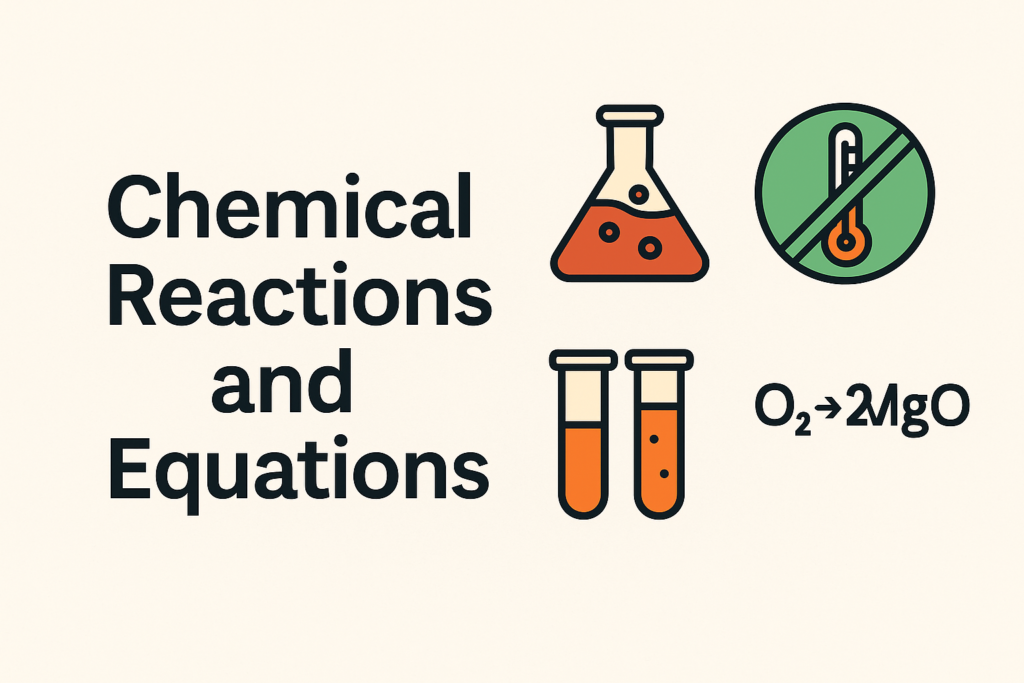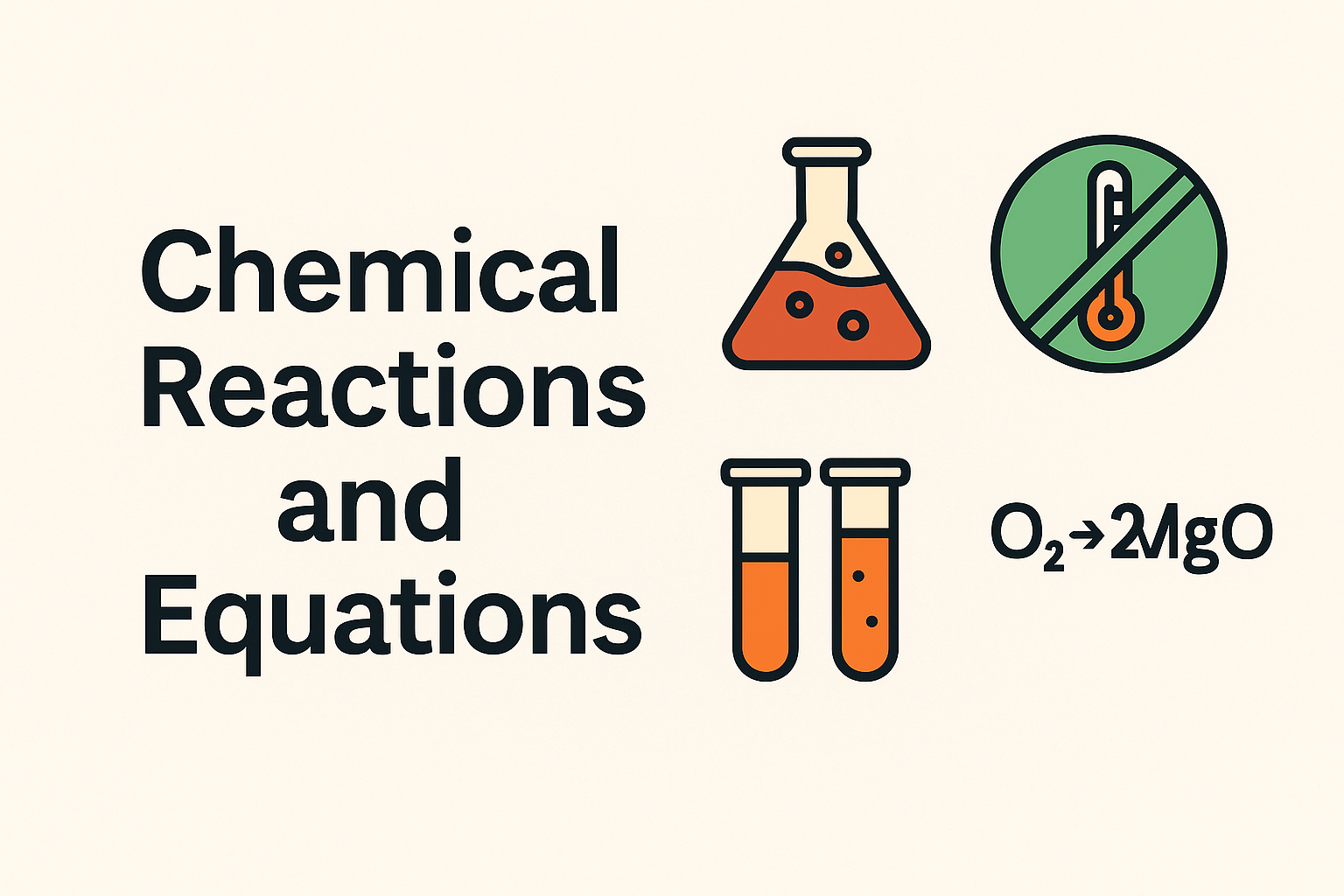Chemical Reactions and Equations Class 10 question answer. Get comprehensive Class 10 Science Chapter 1 notes with intext & exercise question-answers. Understand types of reactions, balancing equations, corrosion, and more. Fully updated for 2025-26 NCERT syllabus.

Chemical Reactions and Equations Class 10 question answer

Chapter Summary: Chemical Reactions and Equations
This chapter introduces students to chemical changes and how to represent them using chemical equations. It explains how to balance these equations according to the law of conservation of mass and classifies reactions into different types – combination, decomposition, displacement, double displacement, and redox. It also discusses everyday chemical phenomena like corrosion and rancidity.
📌 Important Points to Remember
- Chemical Reactions are changes where new substances are formed.
- Indications of a reaction: change in color, temperature, state, gas evolution.
- A balanced chemical equation obeys the law of conservation of mass.
- Physical states are denoted using: (s), (l), (g), (aq).
- Types of Reactions:
- Combination
- Decomposition (thermal, photolytic, electrolytic)
- Displacement
- Double Displacement (precipitation)
- Redox
- Exothermic Reactions release heat (e.g., respiration).
- Endothermic Reactions absorb heat/light/electricity (e.g., electrolysis).
- Corrosion is metal degradation due to air/moisture.
- Rancidity is spoilage of fats due to oxidation.
❓ Intext Questions with Answers
Q1. Why should a magnesium ribbon be cleaned before burning in air?
Ans: To remove the protective layer of basic magnesium carbonate so that it burns easily in air.
Q2. Write balanced equations:
(i) Hydrogen + Chlorine → Hydrogen chloride
Ans: H₂ + Cl₂ → 2HCl
(ii) Barium chloride + Aluminium sulphate → Barium sulphate + Aluminium chloride
Ans: 3BaCl₂ + Al₂(SO₄)₃ → 3BaSO₄ + 2AlCl₃
(iii) Sodium + Water → Sodium hydroxide + Hydrogen
Ans: 2Na + 2H₂O → 2NaOH + H₂
Q3. Write balanced chemical equations with physical states:
(i) BaCl₂(aq) + Na₂SO₄(aq) → BaSO₄(s) + 2NaCl(aq)
(ii) NaOH(aq) + HCl(aq) → NaCl(aq) + H₂O(l)
❓ Intext Questions (Page 10)
Q1. A solution of ‘X’ is used for whitewashing.
(i) Name the substance ‘X’ and write its formula.
Ans: X is calcium oxide; formula: CaO
(ii) Reaction with water:
CaO + H₂O → Ca(OH)₂
Q2. Why is gas collected in one test tube double in Activity 1.7?
Ans: Water breaks into 2 parts hydrogen and 1 part oxygen. So, more hydrogen is produced.
❓ Intext Questions (Page 13)
Q1. Why does blue colour of copper sulphate fade when iron nail is dipped?
Ans: Iron displaces copper; forms iron sulphate (greenish), reducing the blue colour.
Q2. Give an example of a double displacement reaction.
Ans: Na₂CO₃(aq) + CaCl₂(aq) → CaCO₃(s) + 2NaCl(aq)
Q3. Identify oxidised and reduced substances:
(i) 4Na + O₂ → 2Na₂O
Na is oxidised, O₂ is reduced
(ii) CuO + H₂ → Cu + H₂O
CuO is reduced, H₂ is oxidised
📚 Exercise Questions with Answers
Q1. Which statements about: 2PbO + C → 2Pb + CO₂ are incorrect?
Ans: (ii) (a) and (c) are correct answers.
Q2. Reaction type: Fe₂O₃ + 2Al → Al₂O₃ + 2Fe
Ans: (d) Displacement Reaction
Q3. Dil. HCl + Iron →
Ans: (a) Hydrogen gas and iron chloride are produced.
Q4. What is a balanced chemical equation?
Ans: A chemical equation with equal number of atoms of each element on both sides. It’s balanced to satisfy the law of conservation of mass.
Q5. Translate and balance:
(a) N₂ + 3H₂ → 2NH₃
(b) 2H₂S + 3O₂ → 2H₂O + 2SO₂
(c) 3BaCl₂ + Al₂(SO₄)₃ → 3BaSO₄ + 2AlCl₃
(d) 2K + 2H₂O → 2KOH + H₂
Q6. Balance:
(a) 2HNO₃ + Ca(OH)₂ → Ca(NO₃)₂ + 2H₂O
(b) 2NaOH + H₂SO₄ → Na₂SO₄ + 2H₂O
(c) NaCl + AgNO₃ → AgCl + NaNO₃
(d) BaCl₂ + H₂SO₄ → BaSO₄ + 2HCl
Q7. Balanced equations:
(a) Ca(OH)₂ + CO₂ → CaCO₃ + H₂O
(b) Zn + 2AgNO₃ → Zn(NO₃)₂ + 2Ag
(c) 2Al + 3CuCl₂ → 2AlCl₃ + 3Cu
(d) BaCl₂ + K₂SO₄ → BaSO₄ + 2KCl
Q8. Identify type of reaction:
(a) KBr + BaI₂ → KI + BaBr₂ → Double Displacement
(b) ZnCO₃ → ZnO + CO₂ → Decomposition
(c) H₂ + Cl₂ → 2HCl → Combination
(d) Mg + 2HCl → MgCl₂ + H₂ → Displacement
Q9. Exothermic vs Endothermic
Exothermic: Releases heat (e.g. CH₄ + O₂ → CO₂ + H₂O + heat)
Endothermic: Absorbs heat/light/electricity (e.g. CaCO₃ → CaO + CO₂)
Q10. Why respiration is exothermic?
Ans: Glucose breakdown in presence of oxygen releases energy.
Q11. Why are decomposition and combination opposite?
Ans: Combination joins substances; decomposition breaks them.
Examples:
- Combination: 2H₂ + O₂ → 2H₂O
- Decomposition: CaCO₃ → CaO + CO₂
Q12. Decomposition types:
- Heat: CaCO₃ → CaO + CO₂
- Light: 2AgCl → 2Ag + Cl₂
- Electricity: 2H₂O → 2H₂ + O₂
Q13. Displacement vs Double Displacement
- Displacement: Zn + CuSO₄ → ZnSO₄ + Cu
- Double Displacement: Na₂SO₄ + BaCl₂ → BaSO₄ + 2NaCl
Q14. Reaction in refining silver:
Cu + 2AgNO₃ → Cu(NO₃)₂ + 2Ag
Q15. What is a precipitation reaction?
Ans: Formation of insoluble solid (precipitate).
Example: BaCl₂ + Na₂SO₄ → BaSO₄(s) + NaCl
Q16. Define:
(a) Oxidation: Gain of O₂ or loss of H (e.g., Zn + O₂ → ZnO)
(b) Reduction: Loss of O₂ or gain of H (e.g., CuO + H₂ → Cu + H₂O)
Q17. Brown element ‘X’ becomes black on heating
Ans: X = Copper; Black compound = CuO
Q18. Why paint on iron articles?
Ans: To prevent rusting (corrosion).
Q19. Why are fats flushed with nitrogen?
Ans: To prevent rancidity by avoiding oxidation.
Q20. Define:
- Corrosion: Metal decay due to environment
- Rancidity: Spoiling of oils/fats due to oxidation
Download pdf:
That’s all for the Chemical Reactions and Equations Class 10 question answer, Chemical Reactions and Equations Class 10, Class 10 Science Chapter 1 Notes, NCERT Solutions Chemical Reactions, Types of Chemical Reactions Class 10, Balancing Chemical Equations Class 10
related article: https://stationvidya.com/class-9-science-chapter-2-notes-exercise-solutions/
You can follow us on Instagram: https://www.instagram.com/stationvidya/
Facebook: https://www.facebook.com/stationvidya/
You tube: https://www.youtube.com/@stationvidya/
We hope you’d loved the content Chemical Reactions and Equations Class 10 question answer, please do like, share and comment.
Subscribe for notification

Leave a Reply